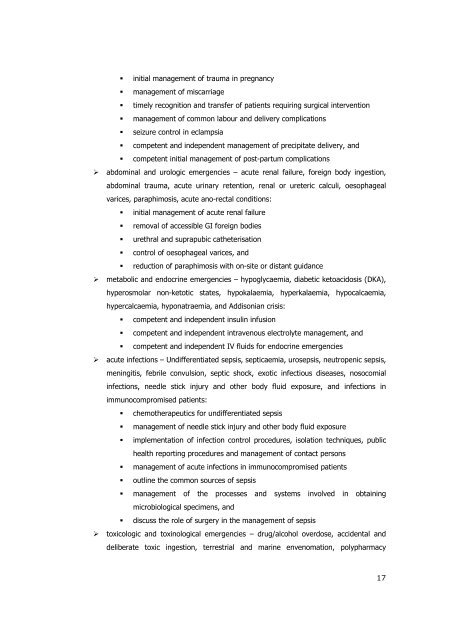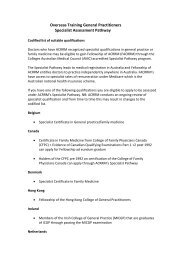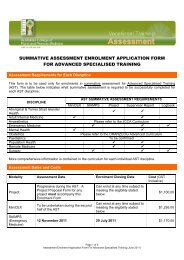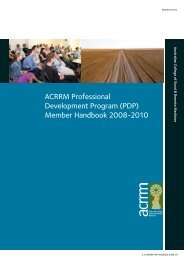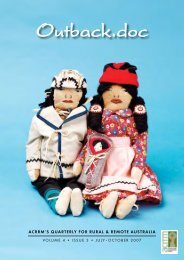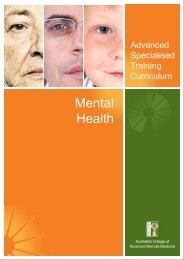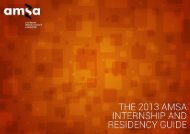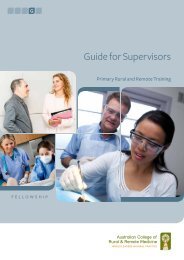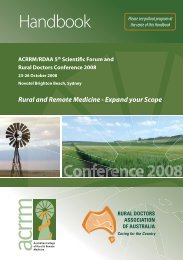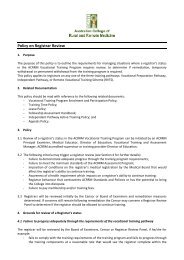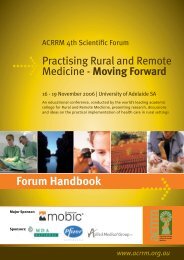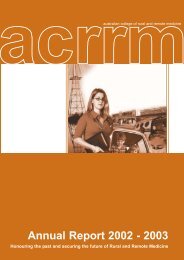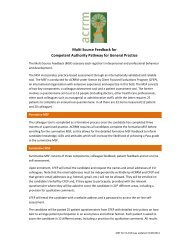ACRRM GEM Curriculum - Final July09 - Australian College of Rural ...
ACRRM GEM Curriculum - Final July09 - Australian College of Rural ...
ACRRM GEM Curriculum - Final July09 - Australian College of Rural ...
You also want an ePaper? Increase the reach of your titles
YUMPU automatically turns print PDFs into web optimized ePapers that Google loves.
initial management <strong>of</strong> trauma in pregnancy<br />
management <strong>of</strong> miscarriage<br />
timely recognition and transfer <strong>of</strong> patients requiring surgical intervention<br />
management <strong>of</strong> common labour and delivery complications<br />
seizure control in eclampsia<br />
competent and independent management <strong>of</strong> precipitate delivery, and<br />
competent initial management <strong>of</strong> post-partum complications<br />
abdominal and urologic emergencies – acute renal failure, foreign body ingestion,<br />
abdominal trauma, acute urinary retention, renal or ureteric calculi, oesophageal<br />
varices, paraphimosis, acute ano-rectal conditions:<br />
initial management <strong>of</strong> acute renal failure<br />
removal <strong>of</strong> accessible GI foreign bodies<br />
urethral and suprapubic catheterisation<br />
control <strong>of</strong> oesophageal varices, and<br />
reduction <strong>of</strong> paraphimosis with on-site or distant guidance<br />
metabolic and endocrine emergencies – hypoglycaemia, diabetic ketoacidosis (DKA),<br />
hyperosmolar non-ketotic states, hypokalaemia, hyperkalaemia, hypocalcaemia,<br />
hypercalcaemia, hyponatraemia, and Addisonian crisis:<br />
competent and independent insulin infusion<br />
competent and independent intravenous electrolyte management, and<br />
competent and independent IV fluids for endocrine emergencies<br />
acute infections – Undifferentiated sepsis, septicaemia, urosepsis, neutropenic sepsis,<br />
meningitis, febrile convulsion, septic shock, exotic infectious diseases, nosocomial<br />
infections, needle stick injury and other body fluid exposure, and infections in<br />
immunocompromised patients:<br />
chemotherapeutics for undifferentiated sepsis<br />
management <strong>of</strong> needle stick injury and other body fluid exposure<br />
implementation <strong>of</strong> infection control procedures, isolation techniques, public<br />
health reporting procedures and management <strong>of</strong> contact persons<br />
management <strong>of</strong> acute infections in immunocompromised patients<br />
outline the common sources <strong>of</strong> sepsis<br />
management <strong>of</strong> the processes and systems involved in obtaining<br />
microbiological specimens, and<br />
discuss the role <strong>of</strong> surgery in the management <strong>of</strong> sepsis<br />
toxicologic and toxinological emergencies – drug/alcohol overdose, accidental and<br />
deliberate toxic ingestion, terrestrial and marine envenomation, polypharmacy<br />
17


